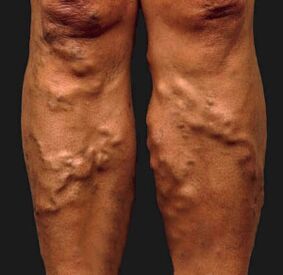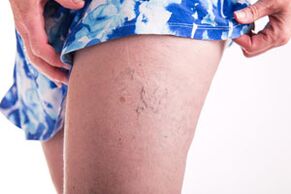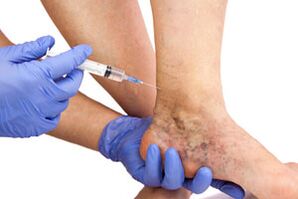
In the event of a violation of venous blood, the pressure in the veins increases, they begin to expand and become visible under the skin.Disease diseases affect the veins of the lower extremities more often, but can occur in any organ of the human body.
General feature
Varicosis on the legs can influence men and women of all ages, but more often found in patients in medium age and in older people.Varicose veins are a very common disease.Up to 15% of the older men and almost all older women suffer from this disease.
Risk factors for the development of pathology:
- the presence of an illness in narrow relatives;
- sitting lifestyle;
- Obesity;
- long stay in a standing position;
- Pregnancy.
The causes of varicose veins
The causes of varicose veins are not fully examined.In some cases, poor blood drainage is caused by the veins by the absence or weakness of the flap apparatus of blood vessels, which are in the depths of the fabrics.In addition, varicose veins of the lower extremities and other organs can be caused by the weakness of the vascular wall itself.
Varicose veins on the legs are less common with the following conditions:
- Transferred inflammation of veins (phlebitis);
- the formation of blood clots in the venous line;
- Congenital anomalies in the development of blood vessels.
The disease is characterized by a progressive course and cannot be completely healed.However, there is a rather effective prevention of varicose veins - the use of compression stockings, normal weight and regular physical activity, mainly go or swim.The dynamic stress on the legs helps the muscles to push the blood into the veins and not to put them in the opposite direction.
Classification of varicose veins

Depending on the location pathologically modified vessels, such forms are differentiated from varicose veins:
- Varicose veins of the small pelvis in women;
- Lesion of the veins of the lower extremities;
- the expansion of the veins of the esophagus during the pathology of the liver;
- Poststrom blue -biatic options in different organs.
There are such phases of varicose veins:
- Compensation: There are no complaints, extended veins on the legs are visible.
- Sub -compensated: patients complain about swelling, bursting, severity in the legs, cramps at night;
- Decompensation: Develop skin changes - hyperpigmentation, signs of chronic inflammation, trophic ulcers.
The clinic often uses the CeaP classification and describes the clinical signs, causes, the localization of the lesion and the type of blood flow disorders.
Symptoms of varicose veins
Only aesthetic symptoms are concerned in the patient's initial stage.In the future, join:
- Pain pain, cramps, itchy;
- Swelling, especially in the evening, severity and tiredness in the legs;
- A feeling of place.
Less more often, but more serious symptoms are:
- Subcutaneous bleeding from a broken vein;
- Thrombophlebitis;
- Trophic ulcers;
- "Wet" dermatitis;
- Rough, knowledgeable changes in the skin.
These complications are much worse for treatment than the pathology at an early stage.
In order to examine the veins on the legs and treat the veins of varicose veins, you must contact a vascular surgeon or phlebologist.The diagnosis necessarily includes venous ultrasonic topics to evaluate the flap apparatus of the blood circulation, the wall of the vessel.
Treatment of varicose veins

Methods for the treatment of varicose veins depend on the size and location of changed veins, the presence of symptoms and skin changes.The treatment of varicose veins is carried out using various methods:
- the increased position of the legs in the position of lying or sitting;
- the use of specially selected compression knitting pathways;
- Sclerotherapy (the introduction of a special drug in the lumen with the formation of a blood clot and the subsequent destruction of the vein);
- Ablation of pathological changed veins with laser, radio frequency and other techniques;
- Surgical treatment of varicose veins on the legs - phlebectomy.
In the early stages of the disease, the doctor prescribes a drug for varicose veins for oral or external use:
- Tablets from varicose veins;
- Ointment from varicose veins with anti -inflammatory, venotonic, anticoagulants and other useful effects.
In addition, many patients use the treatment of varicose veins on the legs with folk remedies:
- Alcohol tinctures of horse detections or calanchoe leaves to rub and compress;
- Compresses from tomatoes, cabbage, calanchoe;
- Infusions of herbs - nettles, joke, chamomile and St. John's wort, raspberries and old people root.
Prevention of the disease
In order to prevent or slow down the development of varicose veins, the doctors suggest comply with such preventive rules:
- regularly the lifting of the legs onto the pillow;
- Rejection of a longer stand;
- the use of preventive compression knitting clothes that can be selected in a pharmacy or a medical business;
- Regular physical activity (walking);
- Weight control;
- If necessary, stand for a long time - do simple exercises (roll from toes to heel, climb socks, rotation in foot).
Such measures will contribute to the mechanical reduction of the load of the venous channel, to improve the valve apparatus of the veins and to maintain the vascular wall.




















